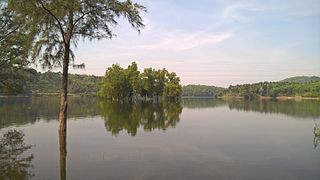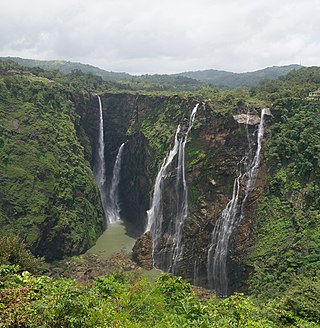
Jog Falls is a waterfall on the Sharavati river located in Siddapur taluk, Uttara Kannada District and its view point is located in Sagara taluk, Shimoga district of Karnataka, India. It is the second highest plunge waterfall in India. It is a segmented waterfall which depends on rain and season to become a plunge waterfall. The falls are major attractions for tourists and is ranked 36th in the list of free-falling waterfalls, 490th in the world by list of waterfalls by total height, 128th in the list of single-drop waterfalls in the World by the waterfall database.
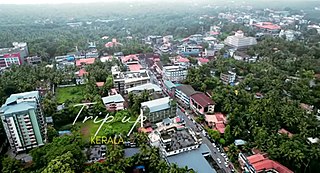
Vatakara,, , French: Bargaret, is a Municipality, Taluk and a major town in the Kozhikode district of Kerala state, India. The municipality of Vatakara covers an area of 23.33 km2 (9.01 sq mi) and is bordered by Mahé to the north and Payyoli to the south. It is the headquarters of Vatakara taluk, which consists of 22 panchayats. During the reign of the Kolathiris and Zamorins, Vatakara was known as Kadathanadu. During the British Raj, it was part of the North Malabar region of Malabar District in the state of Madras. The historic Lokanarkavu temple, made famous by the Vadakkan Pattukal, is situated in Vatakara. A new tardigrade species collected from Vadakara coast has been named after Kerala State; Stygarctus keralensis.

The Idukki Dam is a double-curvature arch dam constructed across the Periyar River in a narrow gorge between two granite hills locally known as Kuravan and Kurathi in Idukki district in the state of Kerala, India. It is constructed and owned by the Kerala State Electricity Board. It supports a 780 MW hydroelectric power station in Moolamattom, which started generating power on 4 October 1975. At 168.91 metres (554.2 ft), it is one of the highest arch dams in Asia. The Indo-Canadian project was inaugurated by the Prime Minister Indira Gandhi on February 17, 1976.

Nagarjuna Sagar Dam is a masonry dam across the Krishna River at Nagarjuna Sagar which straddles the border between Palnadu district in Andhra Pradesh and Nalgonda district in Telangana. The dam provides irrigation water to the districts of Palnadu, Guntur, Nalgonda, Prakasam, Khammam, Krishna, and parts of West Godavari. It is also a source of electricity generation for the national grid.

Hirakud Dam is built across the Mahanadi River, about 10 kilometres (6.2 mi) from Sambalpur in the state of Odisha in India. It is the longest earthen dam in the world. Behind the dam extends a lake, Hirakud Reservoir, 55 km (34 mi) long. It is one of the first major multipurpose river valley projects started after India's independence. Hirakud Reservoir was declared a Ramsar site on 12 October 2021.
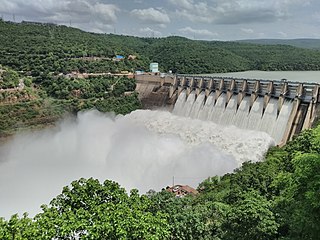
The Srisailam Dam is constructed across the Krishna River in Nandyal district, Andhra Pradesh and Nagarkurnool district, Telangana near Srisailam temple town and is the 2nd largest capacity working hydroelectric station in India.

Banasura Sagar Dam, which impounds the Karamanathodu tributary of the Kabini River, is part of the Indian Banasurasagar Project consisting of a dam and a canal project started in 1979. The goal of the project is to support the Kakkayam Hydro electric power project and satisfy the demand for irrigation and drinking water in a region known to have water shortages in seasonal dry periods. The dam is also known as Kuttiyadi Augmentation Main Earthen Dam. The dam has a height of 38.5 metres (126 ft) and length of 685 metres (2,247 ft).

The Indian state Himachal Pradesh has a large number hydroelectricity resources, about twenty five percent of the national potential. About 27,436 MW of hydroelectric power can be generated in the state by the construction of various hydroelectric projects on the five perennial river basins. Out of total hydroelectric potential of the state, 10,519 MW is harnessed so far, out of which 7.6% is under the control of Himachal Pradesh Government while the rest is exploited by the Central Government. The state government has been giving the highest priority for its development, since hydroelectric generation can meet the growing need of power for industry, agriculture and rural electrification. It is also the biggest source of income to the state as it provides electricity to other states.
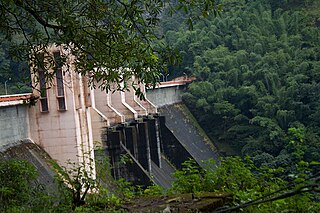
Idamalayar Dam is a multipurpose concrete gravity dam located at Ennakkal between Ayyampuzha and Bhoothathankettu in Ernakulam district of Kerala on the Idamalayar, a tributary of the Periyar River in Kerala, South India. The dam however extends east as far as Malakkappara. Completed in 1985, with a length of 373 metres (1,224 ft) and a height of 102.8 metres (337 ft), the dam created a multipurpose reservoir covering 28.3 km2 (10.9 sq mi) in the scenic hills of the Anamalais.

The Koyna Hydroelectric Project is the second largest hydroelectric power plant in India, just after the Tehri Dam Project. It is a complex project with four dams including the largest dam on the Koyna River, Maharashtra, hence the name Koyna Hydroelectric Project. The project site is in Satara district.
The Kundah Power House is located in the Nilgiris, Tamil Nadu, India. It is one of the biggest electricity generating schemes in Tamil Nadu. The group of peaks Devarbatta, Karaikada, Koulingabetta and Porthimund, all over 2400 Metres ASL drain into two streams, Avalanche and Emerald. Total estimated cost of the Kundah scheme is Rs. 35 44 lakhs. This project is whole of it Canadian Aid under the Colombo Plan Avalanche and Emerald Dams, along with Upper Bhavani, form the major source of water for the Kundah hydro-electric project. The project is a symbol of India-Canada friendship and co-operation. The project was executed by then TNEB Civil engineer R.S. Sankaranarayanan (Retd.), Chennai The Power houses were commissioned from the year 1960 to 1964.

The Moyar Power House is a hydroelectric power station located in the Nilgiris, Tamil Nadu, India. It is run by the Tamil Nadu State Electricity Board. It is 48 km from Ooty and 36 km from Gudalur. The power plant is situated at the bottom of the Moyar Gorge and is accessed by a winch system from the plateau above.

The Koldam Hydropower Station, commonly known as Koldam, is an embankment dam on the Sutlej River upstream of the Dehar Power House. It is 18 km from Bilaspur off the Chandigarh-Manali Highway (NH-21) near Barmana, Himachal Pradesh, India. The main purpose of the dam is hydroelectric power generation and it will support an 800 MW power station. The dam was constructed by NTPC Limited.
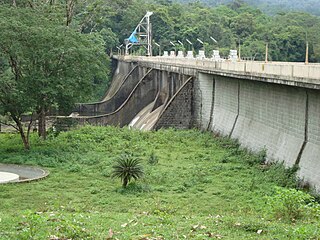
Peringalkuthu Dam is a concrete dam built across the Chalakkudi River in the Thrissur district, Kerala state of India. It also contains the Peringalkuthu Hydro Electric Power Project of Kerala State Electricity Board, who owns the dam. This is the first hydroelectric power project to be built on the Chalakkudi River. The gross storage capacity of the dam is 32 million cubic meters. The dam is situated in a deep forest, and special permission is needed to visit the dam.

Malankara dam is a gravity dam constructed across Thodupuzha river for irrigation purposes. The dam is constructed to make use of the tail water from the Moolamattom power house. The project is run under the Muvattupuzha Valley Irrigation Project and KSEB. The artificial lake covers an area of around 11 square km.
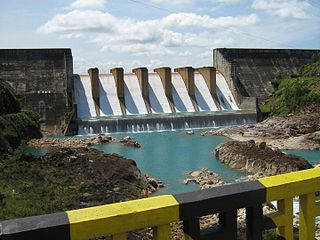
Kopili Hydro Electric Project is a 275 megawatts (369,000 hp), hydroelectric power project on the Kopili river and its tributary, Umrong stream. It is located in Dima Hasao district of Assam state in India. The project is developed and operated by North Eastern Electric Power Corporation Limited. It is an important project since the Indian state of Assam, Arunachal Pradesh, Manipur, Meghalaya, Mizoram, Nagaland and Tripura benefit from this project.

Urumi 2 Weir' is a small diversion dam constructed across Poyilingalpuzha in Thiruvambady village of Kozhikode district in Kerala, India. The weir is constructed across the Poyilingalpuzha river, downstream of Urumi I power house to divert water to Urumi II power house. This is located in Thiruvambady, 50 km away from Kozhikode town. The water from the reservoir is drawn to the Power House through a power channel 470 m long. The Urumi falls near the dam has become a tourist attraction after the hydro electric project came into existence.

Chembukkadavu Weir is a small diversion dam constructed across Chalipuzha in Kodenchery village of Kozhikode district in Kerala, India. The location of the scheme is at Chembukadavu near Tusharagiri in Kodencherry village of Kozhikode district. It is 55 km away from Kozhikode town. The weir is constructed across Chalipuzha river. After power generation, water from the power station is utilised for Chembukadavu II. The Power generated in the station is at 6.3 kV. This is stepped up to 33 kV and transmitted to 110 kV substation, Agasthyamoozhy. The weir and the power house is operated and maintained by Kerala State Electricity Board.
Valook Weir is a small diversion dam constructed across Kavadippuzha in Naripatta panchayath of Kozhikode district in Kerala, India. It is one of the two weirs of Vilangad SHEP. It is located 85 km away from Kozhikode town. It is a run- off the river scheme utilizing water of Vaniyampuzha and Kavadipuzha. The weir has a height of 7.9 metres (26 ft) from deepest foundation and a length of 45.95 metres (150.8 ft).

Manjoora Saddle dam is an earthen dam constructed across Karamanthode which is a tributary of Kabani River in Thariyode village of Wayanad district in Kerala, India. It is one of the six saddle dams of Banasura sagar reservoir built as oart of the Kuttiyadi Augmentation scheme.







